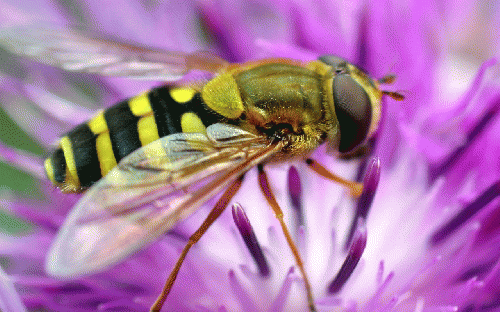Shortly after graduating college in 1971, I spent a year co-managing a Congressional campaign in what was then California's 16th Congressional District. Located in the heart of "Steinbeck Country," the district extended from Santa Cruz on the northern tip of the Monterrey Peninsula to south of Carmel along the coast, and took in such inland farming communities as Watsonville, Salinas, Gilroy, and Castroville, known as the world's leading growers of, respectively, berries, lettuce, garlic and artichokes.
One day, while driving the candidate, Julian Camacho, through the heart of the Salinas Valley, I noted a befuddled look on his face.
"What's on your mind?" I asked.
"Your windshield," he said, pointing to the my VW van's front window.
"What's wrong with it?" I asked. "It looks perfectly clean and clear to me."
"That's the problem," Julian said, shaking his head. "There should be about a million dead bugs on the window; instead there aren't any . . . and that's a big, big problem."
"Why?" I asked, realizing that indeed, there weren't any squashed bugs on the windscreen.
"Because it means that the pesticides have killed 'em off . . . and if the bugs and bees can't live, how much longer do you think we humans have . . . ?"
Up until last Tuesday, this little vignette had been hidden from my conscious memory for more than 40 years. So what happened on Tuesday? I was made aware of a new piece of legislation, H.R. 2692, the "Saving America's Pollinator's Act of 2013." According to its sponsors, Representatives Earl Blumenauer (D-OR and John Conyers (D-MI):
"Bee populations are in serious jeopardy. From flowers to chocolate, berries to tequila, pollinators are integral to the planet, economy, and many aspects of our lives. In fact, the USDA estimates that about one in every three bites of food is either directly or indirectly made possible because of bee pollination. Both our environment and food supply are inextricably tied to the welfare of bees, making the decrease in bee populations a cause for great alarm."
In doing some further research, I learned that there are more than 20,000 known species of bees in seven to nine recognized families. Bees can be found on every continent except Antarctica -- which has no flowering plants -- and are essential to the production of food. Without them, staples as diverse as berries, nuts, corn, wheat and sorghum don't stand much of a chance of maturing, ripening or becoming edible. I further learned, much to my horror, that according to a recent survey of America's beekeepers almost a third (31% to be precise) of the country's honeybee colonies did not make it through the winter. Moreover, that's been the case almost every year since the U.S. Department of Agriculture began this annual survey, six years ago. Historically, a drop of 12%-15% is expected; the 31% figure is cause for great alarm. In just one reported episode -- which may be the single-largest bee die-off on record -- 50,000 plus bees were recently found littering the parking lot of a Target store in Wilsonville, Oregon, shortly after a landscaping company had sprayed surrounding trees with an insecticide called Safari.
The apian die-off was so dramatic that the Oregon Department of Agriculture enacted a temporary ban on the pesticide used in this incident, and for an additional 17 other insecticide products containing the chemical dinotefuran, which is a popular insecticide found in agricultural, professional and household products.
(n.b. Dinotefuran is an insecticide of the neonicotinoid class, a class of insecticides widely suspected to be the primary cause of the global bee and pollinator die-off we are witnessing today. Neonicotinoids -- a class of neuro insecticides chemically related to . . . you guessed it . . . nicotine -- include a number or insecticides other than dinotefuran, and have for decades been suspected of being especially dangerous to bees.)
Less than 2 months ago, the European Union (EU) voted to make the use of 3 pesticides illegal. EU officials are banking on the fact that banning the pesticides will help restore populations of honey bees, which as in America, have been dying off at a mind-numbing rate. Speaking of their decision to initiate the ban, EU Health and Consumer Commissioner Tonio Borg said, "I pledge to do my utmost to ensure that our bees, which are so vital to our ecosystem and contribute over --22 billion ($28.8 billion) annually to European agriculture, are protected." Once again, the Europeans are ahead of us. One of the reasons is that in Europe, they leave science to scientists -- not corporations, not politicians, not lobbyists and certainly not Biblical literalists.
I know, I know: in comparison to such gripping issues as political uncertainty in Egypt, civil war in Syria, the question-mark that is Iran, unemployment, the staggering cost of health insurance, terrorism and domestic spying -- to name but a few -- the plight of the honeybee seems so incredibly tame and third-tier. But it is not. Remember Julian's admonishment: "If the bugs and the bees can't live, how much longer do you think we humans have?"
You had better believe that the pesticide lobby is going to be showering members of the House Agriculture Committee (to which H.R. 2692 has been assigned) to make sure that it never gets a hearing -- much less makes it onto the floor for a vote. As of today, www.Govtrack.u s gives the bill a 7% chance of getting passed by the committee and 0% chance of being enacted. When you consider just how incredibly crucial the apian world is to ours -- and how incredibly dysfunctional Congress is when it comes to anything but being obtuse -- these figures are more than disheartening. It makes one feel even less in charge of their destiny than the simple honeybee.
(Note: You can view every article as one long page if you sign up as an Advocate Member, or higher).






